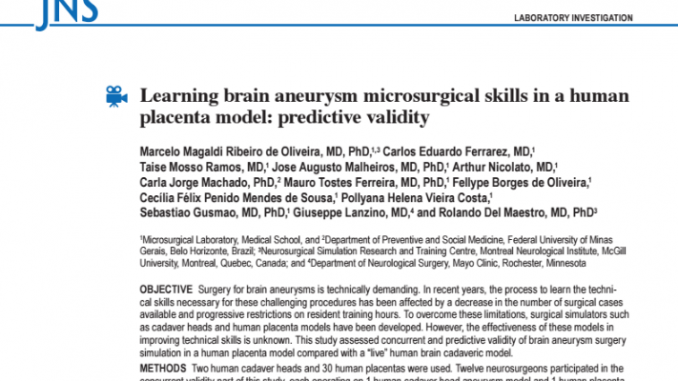
[PDF] [Journal]
Journal of Neurosurgery 2017 Mar 24:1-7 [E-pub ahead of print]
Marcelo Magaldi Ribeiro de Oliveira, MD, PhD,1,3 Carlos Eduardo Ferrarez, MD, Taise Mosso Ramos, MD, Jose Augusto Malheiros, MD, PhD, Arthur Nicolato, MD, Carla Jorge Machado, PhD, Mauro Tostes Ferreira, MD, PhD, Fellype Borges de Oliveira, Cecília Félix Penido Mendes de Sousa, Pollyana Helena Vieira Costa, Sebastiao Gusmao, MD, PhD, Giuseppe Lanzino, MD, and Rolando Del Maestro, MD, PhD
OBJECTIVE Surgery for brain aneurysms is technically demanding. In recent years, the process to learn the techni-
cal skills necessary for these challenging procedures has been affected by a decrease in the number of surgical cases available and progressive restrictions on resident training hours. To overcome these limitations, surgical simulators such as cadaver heads and human placenta models have been developed. However, the effectiveness of these models in improving technical skills is unknown. This study assessed concurrent and predictive validity of brain aneurysm surgery simulation in a human placenta model compared with a “live” human brain cadaveric model.
METHODS Two human cadaver heads and 30 human placentas were used. Twelve neurosurgeons participated in the concurrent validity part of this study, each operating on 1 human cadaver head aneurysm model and 1 human placenta model. Simulators were evaluated regarding their ability to simulate different surgical steps encountered during real surgery. The time to complete the entire aneurysm task in each simulator was analyzed. The predictive validity component of the study involved 9 neurosurgical residents divided into 3 groups to perform simulation exercises, each lasting 6 weeks. The training for the 3 groups consisted of educational video only (3 residents), human cadaver only (3 residents), and human placenta only (3 residents). All residents had equivalent microsurgical experience with superficial brain tumor surgery. After completing their practice training, residents in each of the 3 simulation groups performed surgery for an unruptured middle cerebral artery (MCA) aneurysm, and their performance was assessed by an experienced vascular neurosurgeon who watched the operative videos.
RESULTS All human cadaver heads and human placentas were suitable to simulate brain aneurysm surgery. In the concurrent validity portion of the experiment, the placenta model required a longer time (p < 0.001) than cadavers to complete the task. The placenta model was considered more effective than the cadaver model in simulating sylvian fissure splitting, bipolar coagulation of oozing microvessels, and aneurysm neck and dome dissection. Both models were equally effective in simulating neck aneurysm clipping, while the cadaver model was considered superior for simulation of intraoperative rupture and for reproduction of real anatomy during simulation. In the predictive validity portion of the experiment, residents were evaluated for 4 tasks: sylvian fissure dissection, microvessel bipolar coagulation, aneurysm dissection, and aneurysm clipping. Residents trained in the human placenta simulator consistently had the highest overall performance scores when compared with those who had trained in the cadaver model and those who had simply watched operative videos (p < 0.001).
CONCLUSIONS The human placenta biological simulator provides excellent simulation for some critical tasks of aneurysm surgery such as splitting of the sylvian fissure, dissection of the aneurysm neck and dome, and bipolar coagulation of surrounding microvessels. When performing surgery for an unruptured MCA aneurysm, residents who had trained in the human placenta model performed better than residents trained with other simulation scenarios/models. In this age of reduced exposure to aneurysm surgery and restrictions on resident working hours, the placenta model is a valid simulation for microneurosurgery with striking similarities with real surgery.
